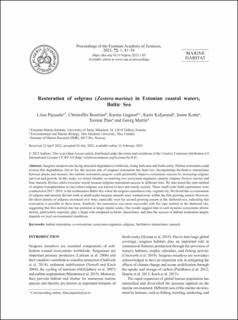| dc.description.abstract | Seagrass meadows are facing structural degradation worldwide, losing both area and biodiversity. Habitat restoration could reverse this degradation, but so far, the success rate of seagrass restoration has been low. Incorporating facilitative interactions between plants and mussels into habitat restoration projects could potentially improve restoration success by increasing eelgrass survival and growth. In this study, we tested whether co-restoring two ecosystem engineers, namely eelgrass Zostera marina and blue mussels Mytilus edulis/trossulus would increase eelgrass restoration success in different sites. We also tested the rope method of eelgrass transplantation in sites where eelgrass was known to have previously existed. These small-scale field experiments were conducted in 2017–2019, in the northeastern Baltic Sea where the eelgrass reproduces only vegetatively. We found that co-restoration of eelgrass and mussels did not work at small scales because mussels were washed away within the first growing season. However, the shoot density of eelgrass increased over time, especially over the second growing season in the sheltered site, indicating that restoration is possible in these areas. Similarly, the restoration was most successful with the rope method in the sheltered site, suggesting that this method also has potential at larger spatial scales. Our results suggest that in such dynamic ecosystems abiotic factors, particularly exposure, play a larger role compared to biotic interactions, and thus the success of habitat restoration largely depends on local environmental conditions. | |
